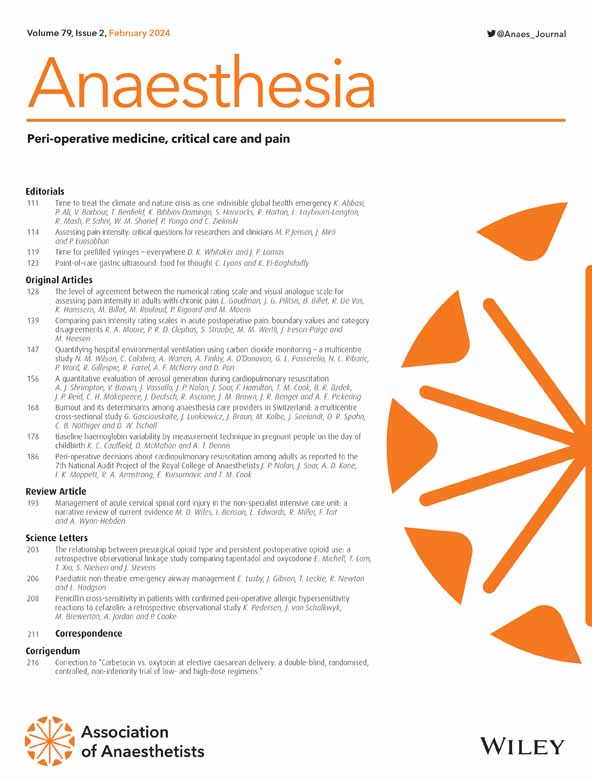静脉注射艾氯胺酮预防小儿腺扁桃体切除术后出现谵谵症和阴性行为改变:一项随机对照试验。
IF 6.9
1区 医学
Q1 ANESTHESIOLOGY
引用次数: 0
摘要
25-60%的患儿术后出现突发性谵妄,表现为急性精神错乱、定向障碍和躁动。这种情况在腺扁桃体切除术后特别常见,并可导致大约50%的受影响儿童持续数周的负面行为改变。方法我们对3-7岁接受腺扁桃体切除术的儿童进行了一项单中心、前瞻性、双盲、随机对照试验。患者静脉注射艾氯胺酮0.2 mg。腺样组织切除后,Kg-1或等量0.9%生理盐水。共同主要结局是术后第7天出现谵妄和不良行为改变的发生率。结果随机分配228例患者。与0.9%生理盐水组相比,艾氯胺酮组儿童出现性谵妄的发生率较低(19/ 114,17 % vs. 49/ 114,43 %;相对风险0.40,97.5%CI 0.23-0.68, p < 0.001)。与0.9%生理盐水组相比,艾氯胺酮组患儿术后第7天的不良行为改变较低(48/114,42%比70/114,61%;相对风险0.70,95.5% ci 0.51-0.95, p = 0.009)。获益延长至术后第30天,镇痛改善,家长满意度提高。两组不良事件发生率相似。在接受腺扁桃体切除术的儿童中,术中低剂量静脉注射艾氯胺酮可显著减少出现性谵妄和阴性行为改变,而不会增加不良事件。这种干预提供了一种安全、有效的方法来改善儿科手术结果。本文章由计算机程序翻译,如有差异,请以英文原文为准。
Intravenous esketamine for the prevention of emergence delirium and negative behavioural changes after paediatric adenotonsillectomy: a randomised controlled trial.
INTRODUCTION
Emergence delirium affects 25-60% of children after surgery, manifesting as acute confusion, disorientation and agitation. This condition is particularly common following adenotonsillectomy and can lead to negative behavioural changes that persist for weeks in approximately 50% of affected children.
METHODS
We conducted a single-centre, prospective, double-blind, randomised controlled trial in children aged 3-7 y undergoing adenotonsillectomy. Patients received either intravenous esketamine 0.2 mg.kg-1 or an equivalent volume of 0.9% saline after adenoid tissue resection. The co-primary outcomes were the incidence of emergence delirium and negative behavioural changes on postoperative day 7.
RESULTS
A total of 228 patients were allocated randomly. Emergence delirium was less frequent in children allocated to the esketamine group compared with those allocated to the 0.9% saline group (19/114, 17% vs. 49/114, 43%; relative risk 0.40, 97.5%CI 0.23-0.68, p < 0.001). Negative behavioural changes on postoperative day 7 were lower in children allocated to the esketamine group compared with those allocated to the 0.9% saline group (48/114, 42% vs. 70/114, 61%; relative risk 0.70, 97.5%CI 0.51-0.95, p = 0.009). Benefits extended to postoperative day 30, with improved analgesia and greater parental satisfaction. Adverse event rates were similar between groups.
DISCUSSION
In children undergoing adenotonsillectomy, intra-operative low-dose intravenous esketamine significantly reduced emergence delirium and negative behavioural changes without increasing adverse events. This intervention offers a safe, effective approach to improving paediatric surgical outcomes.
求助全文
通过发布文献求助,成功后即可免费获取论文全文。
去求助
来源期刊

Anaesthesia
医学-麻醉学
CiteScore
21.20
自引率
9.30%
发文量
300
审稿时长
6 months
期刊介绍:
The official journal of the Association of Anaesthetists is Anaesthesia. It is a comprehensive international publication that covers a wide range of topics. The journal focuses on general and regional anaesthesia, as well as intensive care and pain therapy. It includes original articles that have undergone peer review, covering all aspects of these fields, including research on equipment.
 求助内容:
求助内容: 应助结果提醒方式:
应助结果提醒方式:


